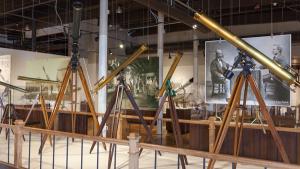
Robert B. Ariail Telescope Collection
In 2011, Columbia resident Robert Ariail donated his world-class collection of antique telescopes and astronomical instruments to the South Carolina State Museum. The telescopes and instruments total more than 200 objects dating back to 1730. Of the more than 60 telescopes in the group, 23 are fine examples of 19th and early 20th century American-made telescopes. More than half of these were made by Alvan Clark & Sons, makers of some of the finest refracting lenses in the world.
The telescopes and instruments are housed in a dedicated exhibition gallery next to the museum’s Boeing Observatory on the fourth floor.
Hi I'm Tom Falvey I'm the Director of Education here at the South Carolina State Museum and we're in the Robert B Ariel collection of historical astronomy. One of the first telescopes the first telescope that greets you is this beautiful instrument made by Henry Fitz a New York maker. It was delivered to Erskine College in due west South Carolina in 1849. The telescope was used for many years and then fell into disrepair and our donor, Robert Ariel, found it,brought it back here to Columbia and over a 13 year period was able to restore it to this beautiful shape it's in. This telescope, we believe is the oldest known observatory instrument and the oldest made in America observatory instrument that still survives today so it's a great piece of American history and a great piece of South Carolina history. Telescopes at this time were very rare in America, all telescopes had been made in Europe before this time, so this is a great instrument to look to come and see and to learn a little bit more about American observatories and American ingenuity.
We're gonna look at Fitz's workshop next and Fitz worked in his own workshop, he made his own tools. He had a couple of apprentices, his son and an Irishman named John Byrne working with him and this workshop is a representation of the tools that he made by hand. He taught himself astronomy, he taught himself telescope making. He also made cameras and he traveled to France and Germany studied with Daguerre to learn how to do some of this work. He brought it back to America and this is the result. So this recreation of Fitz's workshop which was on Long Island in New York is a place where you can see 19th century telescope making at its finest.
Let's take a look at some of the American instruments which is really what we pride ourselves with here in South Carolina at the State Museum. This collection is just some of what we have and these telescopes represent some of the finest made instruments in the United States at the time and what happened of course was as America started making great instruments observatories popped up and science started happening and it's a great story when you think about all that was happening during the American industrial revolutions in the nineteenth century and these instruments play an important part of it.
And one really important instrument right here on this riser is the John Brashear telescope. John Brashear was a Pittsburgh maker. He was making in the early 1900's late 1800s and this telescope was made in Pittsburgh, it's an early Brashear and he was a machinist. Now people regular folks who could not afford telescopes, telescopes truly were for the rich, John Brashear helped to make telescopes affordable to everybody and it began that process that made made telescope making available to everybody. So as a machinist, there were people who could do machining work, they could do the metalwork, they could do the wood work, but they couldn't necessarily make the lenses. So there was a whole business in just making lenses where the light comes through and all the fine work has to be done. And then the machining, people who had farms, people had all of those other skills, could do those works so he could he could make that happen for people so that they could have telescopes. And then following that some of these later telescopes that go down the line our commercial telescopes and this is when telescope making became a production thing rather than something custom made by people who were self-taught. So this entire spectrum of telescopes give you a gives you a sense of all of the telescopes that were made during this period this really important period of American telescope making in America.
Arial Collection Images

About the Alvan Clark Observatory Telescope
Find out how the Observatory's historic telescope made its way from New York City to the South Carolina State Museum.




















